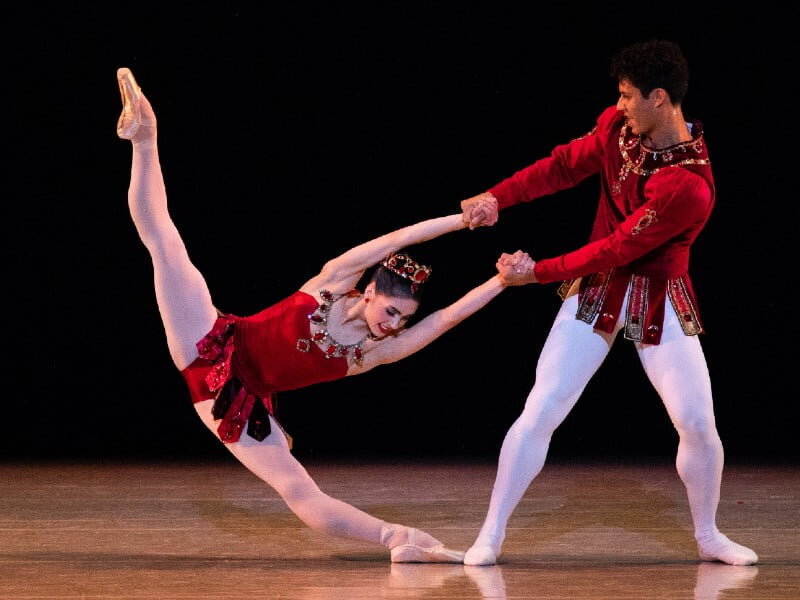On Thursday night around 9 pm, I sat down to watch Ballet West’s latest in their Winter Streaming series — Balanchine’s Rubies. At just over twenty minutes in length, an excavated chunk like this is exactly how much televised ballet I want to watch after staring at my other, smaller, screens all day. Selecting shorter one-acts and breaking up full-length evening works like Jewels may be helping BW stretch their pre-covid filmed content, but it’s also a really welcome choice from a viewer’s perspective.
I watched the three-minute Director’s Pointe introduction video first. There’s a little background history, a little setting the tone, a crackling fire — Adam Sklute is having a great time. Although each week’s selection for the series is only up for seven days, these introductory snippets remain posted on the BW YouTube channel — if you’ve missed one you can still watch the highlight reel.
In Rubies, all the Ballet West dancers are predictably gorgeous. The two leads, Katlyn Addison and Beckanne Sisk, carry the piece confidently. Addison shines, sharp and hypnotic. Sisk’s natural, jubilant snakiness makes her an obvious and perfect fit for her role.
Beckanne Sisk and Hadriel Diniz in George Balanchine's Rubies
Rubies isn’t my favorite. It’s sassy, it’s silly, it’s impressive, but it’s just not quite my thing. I think perhaps when I first saw it as a young teen just discovering Balanchine and neoclassical ballet I appreciated its flashiness a little more, but as an adult who’s seen a lot more neoclassical work, been out of the professional game a few years and shed a few layers of loaded associations, I’m more drawn to the serene elegance of Emeralds and the effervescent precision of Diamonds. But, that being said, this was the perfect way to revisit it.
Short enough to hold my attention and gently release it. Available on demand from my couch, dog in lap. The ability to pause to refill a beverage, text a friend back, rewind to watch a particularly stunning moment from Katlyn Addison — all together an infinitely more accessible format that prompted me to give a moment of my time to rewatching something I might not have opted to otherwise.
It’s been said a few times over the last year, but I think it’s an ask that bears continual amplification — all the accessible, low-cost to free streaming options in performances and classes that have popped up in response to the pandemic are a good thing for ballet. It’s a development I hope we hold onto even once theaters are back open in full. It’s not going to dim the brightness of live performance. It won’t make those who are already regular ballet-lovers skip the ticket line or the class punch-card. What it could do is allow us to keep sharing more and more of our art with anyone and everyone who doesn't want to or can’t make it to us in person. If we’re serious when we say we want to bring in as many people as possible, and make ballet a more relevant part of mainstream culture — with all the attendant benefits that come with that — it would be foolish to think we can achieve it without allowing ballet to exist in the places and forms where it can be most widely transmitted.
Catch Rubies through tonight (Friday), and be on the lookout for Diamonds later this season.
Emily Snow is a Denver native who now calls Salt Lake City home. She has most recently been seen performing with Municipal Ballet Co. and with Durian Durian, an art band that combines electronic music and postmodern dance.











